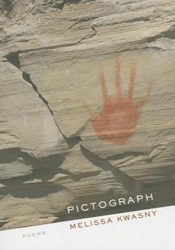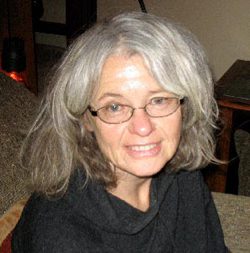
There are times when silence is the best response. A friend tells you she’s found a lump. You linger over the last embers of a dying campfire. You read Melissa Kwasny’s new collection of poems, Pictograph, for the first time. But I’m afraid silence won’t really work in this format. And even if I were just to say, “Read this book. Then sit in silence,” you wouldn’t do it. So I suppose I’ll have to rely on more traditional means, profane though they may be under the circumstances.
Here are the basics: The book is made up of 63 prose poems across three sections. The poems revolve around ancient, indigenous pictographs found in the caves and on the cliffs of Western Montana. Each poem is of roughly equal length, laid out in 10-13 lines in a single block.
But that is where convention ends. The poems are some of the deepest meditations I can recall reading. Though they spiral through some well-trod territory—mortality and grief, kinship with the natural world, the traces we leave behind—they follow an uncharted path. The pictographs of the title—with their fantastical animals and distended humans and hybrids of the two—serve as a kind of glossary for the deep mysteries, the ones that don’t have names in English or any written language but are locked inside the caves of the Intermountain West. For example, consider this from “Pictograph: Possible Shield-Bearing Figure”:
Yesterday, I had one of the Old Days. As they say, my solitude was extended. An implied but un-depicted ground line. An abstract foothills tradition. The sound of rivers can lead me back there, to what I am being carried along to find. Their lives, this one, a kind of drowning. Imagine it summer. The rock shelter is dry. Scrape of chert. Chirr of insects in the fescue. The earth alive in ways I am not. Dead in ways beyond my reckoning.
One gets the sense that Kwasny is trying to teach herself the language—or maybe more accurately, the sensibility—of the pictographs as she examines the sandstone walls and the people and creatures who surround her. And in reporting back, Kwasny pushes the images one step further—I want to say deeper—than the reader expects. She starts “Lost Pictograph” here: “The light darkened, stained to the thin color of Chinese tea,” which is evocative enough. But she goes on: “then lost its muscle and unraveled. Dust covering the shine we lost on surfaces.”
As the book traverses the depths of caves and their paintings, there are times when it feels as if Kwasny has cracked the code of the unconscious. It feels as if the seen and the unseen are in rare equipoise. As Kwasny puts it in “Translation”:
The Greeks used the word “translate” to talk of the gods whisking mortals away, to a land not in this world but also not in hell, where they live, not dead but far removed.
 The spell is never permanent though. Kwasny is transparent in that access to the netherworld is fleeting. As she says in “The Missouri Breaks,” “To get too close is to lose sight of them: the row of tall robed women, the perched, staring eagles, the climbing child, the slow turn they accomplish when they sense us.” And—on at least one occasion (in “The Phenomenology of Fire”)—Kwasny hints at how worldly despair sometimes overrides transcendence:
The spell is never permanent though. Kwasny is transparent in that access to the netherworld is fleeting. As she says in “The Missouri Breaks,” “To get too close is to lose sight of them: the row of tall robed women, the perched, staring eagles, the climbing child, the slow turn they accomplish when they sense us.” And—on at least one occasion (in “The Phenomenology of Fire”)—Kwasny hints at how worldly despair sometimes overrides transcendence:
I remember closing the blinds, noting that I rarely do, as if willing myself to blindness. I remember listening to the wind and hearing objects fall that I did not go out to see, willing deafness. I tightened myself into the house. . . .Blackbirds falling right out of the skies while we lobby for still more concealed weapons. If we still believed in shamans, their task might be too large, to mediate between the village and the weather. Communion at the interior: earth with its core of flame. Over six thousand miles to its center.
The book—like a closely considered life—shimmers between moments of shattering insight and those marked by distraction and obtuseness. The poem “Pictograph: Shield with Lunar Eclipse” reveals the poet’s work in shuttling between the two:
Milk in the eyes. Whatever the moon sees, she nourishes. The other way of being we have turned our backs on: the over-grown path, the door strangled with vines, the jar of sticks somehow connected to my grandfather, who is himself perhaps a sign. How we insist on being unhinged from each other . . . A poet writes that the three most important questions are dawn, noon, and midnight, without which the day proceeds without punctuation. Noon, unchanging, too close and bright to see, too still without the ornaments of god. We live between the other two as between the sound of two streams. The moon resembles a painting done in bonze. I am getting warmer, darker, aware of having limbs, aware of something trying to straighten them.
That is not to say the book is perfect. Prose poems generally—and these especially—are an inhospitable breed. On the page, they look like salt box houses with the shades down and the doors bolted. Even though I was transfixed by Kwasny’s sensibility, it took effort to begin reading each new poem, as if I had to clamber over a high wall to get inside. Once I breached the wall, I felt welcomed and warmly spoken to but that was despite the form, not because of it.
In addition, because of the singular form, stance, and preoccupations, the poems tend to sound very similar and to pose the same questions over and over. And though I did not grow weary straining alongside Kwasny—struggling to see in the dark—I can imagine that another, less enchanted reader might find the entirety of the book a bit repetitive.
But those flaws—if they are flaws—are minor in the face of a fierce exploration of the world’s depths. The book does not flinch or hedge its bets by even nodding at irony. It is utterly earnest in its joys and despairs, and in the end, it is that earnestness—in the face of a smug and ironic culture—that gives it authority and grace. It asks, as in the poem “The Bridge,” “Will you emerge again, chilled and flowerless, in your hands the dim lamp? Or will you brave an intimacy with something new?”
Read this book. Then sit in silence.




